Exploring Amyloid Plaques and Tangles in the Brain
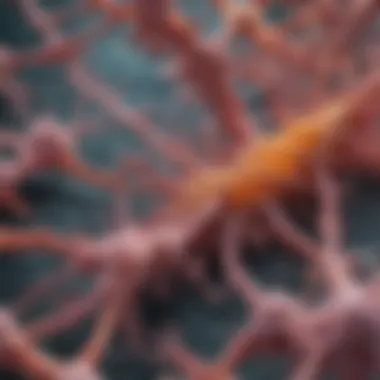
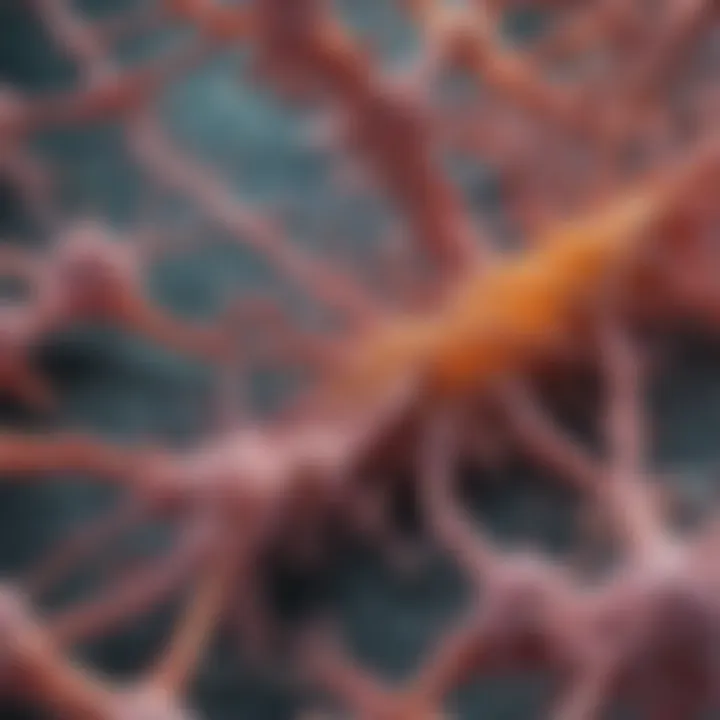
Intro
In the intricate landscape of neurodegenerative diseases, the emergence of two notorious culprits—the amyloid plaques and neurofibrillary tangles—has sparked extensive research and discussion. These abnormal protein deposits are frequently linked with conditions such as Alzheimer's disease, and their presence has been a focal point for scientists and clinicians alike. Grappling with their complex nature offers not only insight into cognitive decline but also enlightened pathways toward potential therapies.
Understanding the dynamics of these brain anomalies is crucial, particularly as they possess a significant role in disrupting normal neuronal function. Amyloid plaques, composed mainly of beta-amyloid peptides, accumulate outside neurons, while neurofibrillary tangles, largely made up of hyperphosphorylated tau protein, form inside them. This dual presence has raised questions about their pathological significance and biochemistry, as researchers race against the ticking clock of time to unlock their mysteries.
To appreciably navigate through this topic, it's imperative to evaluate recent findings and methodologies employed in research. This exploration aims to unpack the scientific literature surrounding amyloid plaques and tangles, offering a clear view into their mechanisms of formation, implications, and the most promising avenues for therapy.
Preface to Plaques and Tangles
Understanding the complex dynamics of amyloid plaques and neurofibrillary tangles is crucial in unraveling the mysteries of neurodegenerative diseases, especially Alzheimer's. These formations not only serve as pathological indicators but also interfere with cognitive processes, making their study indispensable for both the scientific community and the public.
Definition and Significance
Amyloid plaques and neurofibrillary tangles are abnormalities found in the brains of individuals with Alzheimer’s disease. Amyloid plaques consist primarily of beta-amyloid peptides, which deposit between neurons, forming clusters that disrupt communication. This buildup can trigger inflammatory responses that exacerbate neural damage. On the flip side, neurofibrillary tangles are created from hyperphosphorylated tau protein, which destabilizes the cytoskeleton of neurons, ultimately leading to cell death.
Understanding these definitions helps highlight their significance; they are not just markers of the disease but also active participants in its progression. The presence of plaques and tangles provides insights into Alzheimer’s pathology and potentially helps in the development of targeted treatments.
Historical Context
To appreciate the current findings surrounding plaques and tangles, one must take a step back in time. The story began in the early 20th century, when Alois Alzheimer first described the disease that would bear his name. Alzheimer noted the peculiar changes in the brain tissue of patients, but it wasn’t until decades later that the specific structures were identified. In the 1980s, significant progress was made in recognizing amyloid plaques and neurofibrillary tangles as hallmarks of the disease.
As research continued, the focus shifted from merely recognizing these structures to understanding their role in the disease process. Studies identified correlations between the density of plaques and cognitive decline. Today, advances in imaging technology and biochemistry allow scientists to explore these anomalies in unprecedented detail, shaping the landscape of Alzheimer’s research.
"Our understanding of plaques and tangles is like piecing together a puzzle—each discovery reveals more of the picture, but many pieces are still missing."
In summary, the historical exploration of plaques and tangles provides a foundation for current investigations. Recognizing the importance of these brain anomalies not only illuminates their role in neurodegeneration but also emphasizes the need for continued research. Understanding the progression from definition to discovery paves the way for innovative therapeutic strategies aimed at combating Alzheimer's disease.
Understanding Amyloid Plaques
The exploration of amyloid plaques is like peeling an onion; every layer reveals intricate details about their significance in the realm of neurodegenerative diseases. These plaques are not just a biological curiosity; they are pivotal in understanding conditions like Alzheimer's disease. By delving into their nature, formation, and implications, we gain critical insights that can shape future research and therapeutic strategies.
Composition of Plaques
When we talk about amyloid plaques, we're largely referring to aggregates of beta-amyloid peptides that accumulate in the spaces between nerve cells. But what exactly are these proteins? To break it down, beta-amyloid is a fragment of a larger protein called amyloid precursor protein (APP). Imagine trying to tangent a complex puzzle; the fragments that do not fit together well can end up forming these detrimental clusters.
Some key points regarding their composition include:
- Beta-amyloid peptides: Typically, 40 to 42 amino acids long, they form sticky aggregations that the brain cannot easily clear.
- Neuroinflammatory components: Often, the presence of these plaques is accompanied by inflammatory markers, indicating an ongoing battle within the brain.
- Other proteins: While beta-amyloid is the main constituent, other proteins and lipids can also be found within plaques, adding to their complexity.
Formation and Development
The formation of amyloid plaques is a gradual process, akin to building up sediment in a riverbed. Initially, the production of beta-amyloid from APP happens in a regulated manner. However, as we age, or due to genetic predispositions, this balance can tilt towards excessive production or insufficient clearance.
The stages of development can be outlined as follows:
- Normal Processing: Under healthy conditions, APP is cleaved properly and the resulting fragments are effectively cleared away.
- Imbalance: In certain scenarios, there is an overproduction of beta-amyloid or a failure to clear the existing peptides. This is the tipping point.
- Aggregation: Over time, these peptides begin to clump together, forming oligomers and eventually larger fibrillar plaques.
- Mature Plaque Formation: Once formed, these plaques can cause disruptions in intercellular communication, leading to synaptic dysfunction.
Role in Alzheimer's Disease
The link between amyloid plaques and Alzheimer's disease is strongly supported by both clinical and epidemiological studies. These plaques are postulated to instigate a cascade of neurodegenerative processes that eventually lead to cognitive decline.
Here’s how amyloid plaques impact the brain:
- Synaptic Dysfunction: Plaques disrupt neuronal signaling, hampering the brain's ability to connect information.
- Neurotoxicity: The accumulation of plaques can lead to neuronal toxicity, leading to cell death.
- Increased Inflammation: The presence of plaques often triggers an immune response that further exacerbates brain inflammation, a characteristic feature of Alzheimer's disease.
- Biomarker for Diagnosis: Clinically, the detection of amyloid plaques is used as a biomarker for Alzheimer's, helping to guide diagnosis and treatment plans.
"Understanding the formation and impact of amyloid plaques is crucial for developing interventions that can modify the course of Alzheimer's disease."
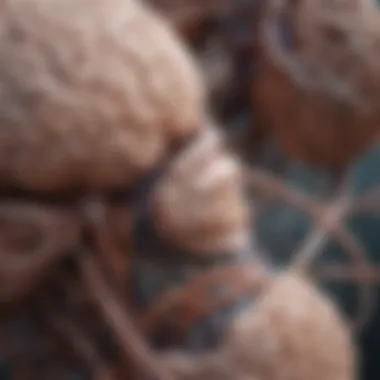

As researchers continue to dissect the complexities of amyloid plaques, their role becomes clearer. From the molecular assembly to the broader implications for brain health, every facet contributes to the overall narrative of cognitive decline, making this an essential area of study in neuroscience.
Neurofibrillary Tangles Explained
Understanding neurofibrillary tangles is crucial in grasping the complexities of neurodegenerative diseases, particularly Alzheimer's. These tangles represent abnormal aggregations of tau protein, a molecule vital for maintaining the structure and function of neurons. Their presence not only serves as a hallmark of Alzheimer’s pathology but also poses significant implications for cognitive health.
The formation of these tangles disrupts communications between neurons and ultimately leads to their death. This domino effect on neuronal networks contributes to cognitive decline, emphasizing why studying them is essential for advancing treatment strategies.
Structure of Tangles
Neurofibrillary tangles take on a distinctive shape, with twisted strands of tau protein aggregating together. Under the microscope, these tangles appear as dense, filamentous structures that twist into spirals. The key elements include:
- Tau Protein Filaments: Composed predominantly of hyperphosphorylated tau, resulting in an unstable and dysfunctional form of the protein.
- Neurotic Processes: These tangles are often surrounded by remnants of neurons that have begun to deteriorate, indicating the not just the presence but the aftermath of toxic changes in the brain.
- Variability in Size and Density: Depending on the stage of disease progression, the size and density of these tangles can vary significantly. Researchers have noted that early stages may show sparse formation, while late stages can display extensive networks throughout the brain.
This structural complexity highlights the challenge in targeting tangles therapeutically, as their interwoven configuration could hinder potential treatments aimed at disassembly.
Mechanism of Formation
Neurofibrillary tangles arise from a series of pathological changes within the neuron. Initially, tau proteins function to stabilize microtubules, which are crucial for organizing the neuron's internal structure. However, several triggers lead to an aberrant process:
- Hyperphosphorylation: This alteration of tau proteins causes them to detach from microtubules, leading to instability.
- Aggregation: Detached tau proteins then begin to aggregate, forming abnormally folded structures that accumulate into tangles.
- Neuronal Stress and Injury: Factors such as oxidative stress and inflammation exacerbate tau pathology, further promoting the formation of tangles.
Thus, the mechanism of formation not only underscores tau’s transition from a supportive protein to a central villain in neurodegeneration, but also reveals potential research avenues for early intervention strategies.
Implications for Neuronal Health
Neurofibrillary tangles wield profound effects on neuronal health, directly correlating with cognitive decline observed in conditions like Alzheimer’s. Some significant implications include:
- Impairment of Neurotransmission: The presence of tangles can block synaptic function, leading to poorer communication among neurons.
- Cellular Dysfunction: Neurons struggling with protein aggregation often face disruptions in their metabolic processes, leading to further cellular stress.
- Induction of Cell Death: As tangles accumulate, they cause the apoptosis of nearby neurons, fueling a vicious cycle of cell loss and cognitive impairment.
"The presence of neurofibrillary tangles significantly affects overall neuronal viability, suggesting a pivotal role in the progression of neurodegenerative disorders."
In summary, neurofibrillary tangles present a multifaceted challenge to neuronal health, marking both a symptom and a driver of cognitive decline. Their unique structure, formation mechanism, and deleterious implications for the brain make them a focal point in the quest to understand and combat neurodegenerative diseases.
The Interplay Between Plaques and Tangles
The connection between amyloid plaques and neurofibrillary tangles in the brain is not just a topic of academic interest; it has profound implications for understanding neurodegenerative diseases like Alzheimer’s. Examining how these two pathological features interact sheds light on their combined impact on cognitive decline, offering insights into both the mechanisms of disease progression and potential treatment strategies.
Synergistic Effects on Cognition
The synergy between amyloid plaques and neurofibrillary tangles is a double-edged sword when it comes to cognitive functioning. Individually, these anomalies disrupt neural pathways, but together, they can create a significantly larger impact. Research indicates that amyloid plaques may initiate toxic cascades that lead to the formation of tangles, suggesting a domino effect.
- Cognitive Decline: Studies show that the presence of both plaques and tangles exacerbates cognitive decline more than either would alone. Patients exhibiting both pathologies often experience greater impairments in memory and executive function, essential components of cognitive health.
- Synaptic Dysfunction: The presence of amyloid plaques is linked to synaptic dysfunction. Tangles have been found to additionally disrupt intracellular transport. Together, they severely undermine synaptic integrity, impacting communication between neurons.
"The interrelationship between plaques and tangles enhances our understanding of Alzheimer's pathophysiology, emphasizing the need for comprehensive approaches in treatment."
This interaction necessitates a unified view of therapeutic strategies. Instead of targeting one pathology in isolation, there’s growing recognition of the need to address both plaques and tangles to slow or potentially halt cognitive decline.
Pathological Mechanisms at Play
Delving deeper, the pathological mechanisms behind plaques and tangles illustrate a complex narrative of neurodegeneration. Understanding these mechanisms is crucial for developing effective treatments.
- Beta-amyloid Cascade: The abnormal accumulation of beta-amyloid peptides leads to plaque formation. This process triggers a series of neurotoxic reactions, leading to inflammation and oxidative stress, both of which play critical roles in cellular injury.
- Tau Hyperphosphorylation: Neurofibrillary tangles are formed due to the abnormal hyperphosphorylation of tau proteins. This process disrupts the cytoskeletal structure of neurons and leads to cell death. The interplay with amyloid pathology is evident, as the inflammatory response from plaques can create the perfect environment for tau pathology to thrive.
In summary, the interplay between plaques and tangles signifies a complex relationship critical to the cognitive health of individuals. A comprehensive understanding is vital not only for the scientific community but also for patient care. Identifying shared mechanisms can lead to innovative approaches in treatment that could disrupt this catastrophic cycle.
Mechanisms of Cognitive Decline


Understanding the mechanisms behind cognitive decline is crucial in unraveling the complexities of neurodegenerative diseases. In this section, we will delve into how amyloid plaques and neurofibrillary tangles contribute to neuronal dysfunction and deterioration. The implications of cognitive decline extend beyond just memory loss; they encompass a spectrum of cognitive impairments affecting daily life, communication, and overall wellbeing.
Impact on Neurotransmission
Neuronal communication relies heavily on a meticulously balanced system of neurotransmitters. The presence of amyloid plaques can disrupt this delicate balance. These plaques, primarily composed of beta-amyloid peptides, tend to cluster between neurons. This interference can lead to less efficient signal transmission, akin to a traffic jam on a busy road. When neurotransmitter release is hindered, cognitive functions such as attention, learning, and memory can become compromised. Research has shown that areas of the brain involved in memory, like the hippocampus, experience significant neurotransmission issues, directly correlating with clinical symptoms seen in Alzheimer’s patients.
Inflammatory Responses in the Brain
When plaques and tangles accumulate, they provoke an inflammatory response in the brain. Immune cells, such as microglia, are activated in an attempt to clear out the debris. However, this response can have unintended consequences. Instead of facilitating repair, chronic activation leads to a state of sustained inflammation. This is often referred to as neuroinflammation. A key issue here is that inflammatory cytokines may exacerbate neuronal injury and promote the progression of cognitive decline. It’s a vicious cycle where inflammation contributes to further neuronal damage, leading to more cognitive decline and, ultimately, a decline in the individual’s quality of life.
Cellular Damage and Death
The interaction of plaques and tangles contributes significantly to cellular damage and, eventually, neuronal death. Neurofibrillary tangles block essential cellular transport systems, similar to how a blocked highway prevents deliveries from reaching their destination. This interruption affects the neuron’s health and function, leading to an energy crisis within cells. Neurons under such stress may undergo apoptosis, or programmed cell death, which is often a final step in the path to severe cognitive impairment.
This process is overwhelmingly evident in Alzheimer’s. As these tangles push neurons closer to their fate, cognitive abilities further deteriorate, paving the way for an eventual loss of autonomy. To underscore this, studies indicate that the density of tangles correlates with the degree of dementia symptoms, illustrating the undeniable link between cellular health and cognitive function.
"Understanding the mechanisms behind cognitive decline is not merely an academic pursuit; it translates to better patient care and interventions."
In summary, investigating the mechanisms of cognitive decline gives us a clearer picture of how plaques and tangles impact neurotransmission, bring about inflammatory changes, and ultimately lead to cellular decline and death. Each aspect is interwoven with the others, creating a complex tapestry of decline that researchers continue to unravel.
Current Research Trends
Current research trends focus significantly on the understanding of amyloid plaques and neurofibrillary tangles, especially in the context of neurodegenerative diseases like Alzheimer's. This focus is crucial because it drives innovations in how we detect, diagnose, and treat these conditions. By prioritizing these research areas, scientists aim to unravel the complexities surrounding these brain phenomena, which can ultimately lead to improved patient outcomes.
Advancements in Detection and Diagnosis
The landscape of diagnosing amyloid plaques and neurofibrillary tangles is changing rapidly due to advances in imaging technologies and biomarker identification. Tools such as positron emission tomography (PET) scans have made it possible to visualize amyloid deposits in the living brain. This technique allows for early detection of Alzheimer’s before symptoms manifest, significantly altering the approach to treatment.
Moreover, cerebrospinal fluid (CSF) biomarkers like tau protein and amyloid beta proteins are becoming increasingly relevant in diagnostic procedures. By analyzing these elements in fluid samples, researchers can not only diagnose Alzheimer's but also gauge its progression.
"Timely diagnosis can be a game changer, enabling interventions that might slow the cognitive decline associated with Alzheimer's disease."
Exploring Genetic Factors
Genetic research plays a pivotal role in understanding how amyloid plaques and tangles form and their implications for Alzheimer's. Studies involving large cohorts have illuminated the influence of specific genes, such as APOE ε4, which heightens the risk of developing Alzheimer's. This genetic predisposition raises essential questions about its role in the accumulation of plaques and tangles.
Investigators are employing genome-wide association studies (GWAS) to establish connections between genetic variations and Alzheimer's pathology. Such research paves the way for personalized medicine, making it possible to tailor interventions based on an individual's genetic background. It also opens doors for new therapeutic avenues that target these genetic risk factors.
Innovations in Treatment Approaches
Today’s treatment landscape is evolving, with innovative therapies being explored that specifically target amyloid plaques and tau tangles. The promise of monoclonal antibodies, like aducanumab, is a prime example. Aducanumab is designed to facilitate the removal of amyloid plaques from the brain, potentially slowing the progression of the disease. However, the controversies surrounding its approval highlight the ongoing debates in the medical community regarding efficacy and ethics.
Additionally, tau-targeting therapies are gaining momentum. Researchers are investigating tau aggregation inhibitors and methods to reduce tau phosphorylation. These treatment modalities are part of a broader strategy, emphasizing the need for a dual approach that addresses both amyloid plaques and tau tangles.
Incorporating lifestyle factors, like diet and physical activity, into treatment protocols also gains attention, as they might play a supportive role in managing cognitive decline.
Overall, the continued exploration of these research trends not only augments our understanding of Alzheimer’s but holds keys to novel interventions that may one day lead to breakthrough treatments in combating cognitive decline.
Therapeutic Strategies and Challenges
Addressing the complexities surrounding amyloid plaques and neurofibrillary tangles has become a focal point in treating neurodegenerative diseases, particularly Alzheimer's disease. Understanding therapeutic strategies is critical, as these approaches aim to alleviate cognitive decline and slow disease progression. Exploring various methods to target these pathological features unveils the challenges researchers face, including efficacy, safety, and individualized treatment intricacies. By unraveling these elements, we gain insights into the potential of existing and emerging therapies.
Targeting Amyloid Formation
The formation of amyloid plaques is a crucial factor in Alzheimer’s development. Targeting these formations taps into the possibilities of preventing or reducing the accumulation of these toxic proteins in the brain.
- Monoclonal Antibodies: Some treatments currently undergoing research utilize monoclonal antibodies to selectively target and clear amyloid-beta from the brain. Drugs like Aducanumab have received significant attention, sparking conversations about their effectiveness and overall impact on patient outcomes.
- Small Molecules: Other approaches involve small molecules designed to inhibit the aggregation of amyloid-beta, aiming to disrupt the early stages of plaque development. Compounds like Crenezumab have shown promise, though results from clinical trials have been mixed.
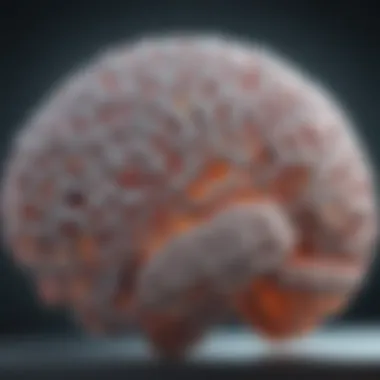
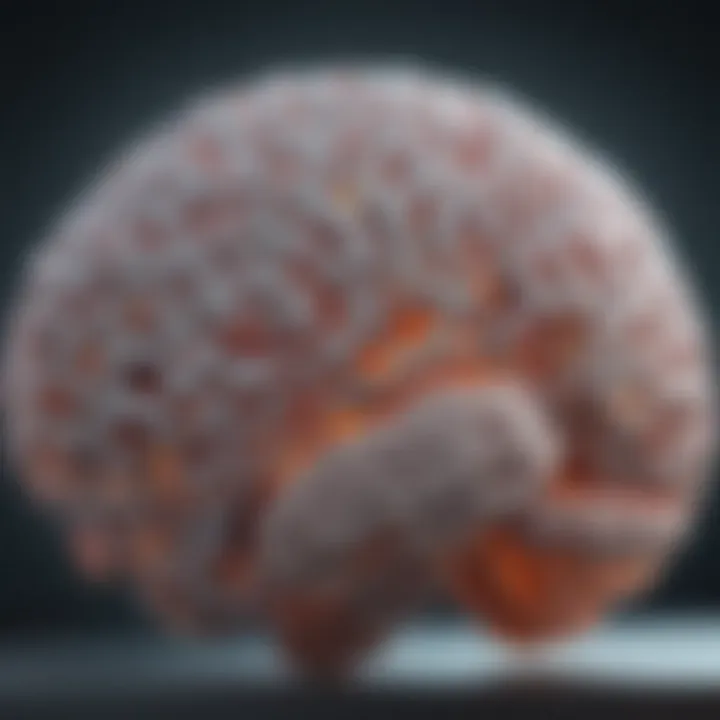
The balancing act between removing plaques and maintaining brain function remains a core challenge in these therapies. Too aggressive targeting might lead to unintended consequences, such as neuronal damage or inflammatory responses.
Addressing Tau Pathology
Beyond amyloid plaques, another significant target is tau pathology, where hyperphosphorylated tau proteins form neurofibrillary tangles. Addressing tau pathology presents additional avenues for therapeutic interventions.
- Tau-based Vaccines: Some researchers are exploring vaccines that could train the immune system to recognize and clear tau tangles. The idea is to develop a response that effectively targets the tangles without harming normal tau proteins which are vital for neuron stability.
- Tau Aggregation Inhibitors: Another line of inquiry involves developing small molecules aimed specifically at inhibiting tau aggregation. For instance, LMTX and Rember are types of tau aggregation inhibitors undergoing study.
However, developing a therapy that specifically targets tau tangles without affecting normal tau functions is complex. The interactions between amyloid and tau proteins complicate these strategies further, which keeps researchers scratching their heads.
The Role of Lifestyle Factors
While pharmacologic treatments are paramount, lifestyle factors shouldn’t be overlooked. Integrating changes in daily living may offer complementary benefits alongside medical interventions.
- Dietary Approaches: Certain diets, for instance, the Mediterranean diet, rich in omega-3 fatty acids, antioxidants, and fiber, might help in reducing risks associated with cognitive decline.
- Exercise: Regular physical activity enhances blood flow to the brain and promotes neurogenesis, potentially offsetting some cognitive decline associated with plaques and tangles.
- Mental Engagement: Lifelong learning and cognitive challenges may bolster brain resilience against the effects of plaques and tangles by promoting synaptic connections and enhancing cognitive reserves.
"Combining lifestyle factors with drug therapies creates a holistic approach to tackle the effects of Alzheimer’s, acknowledging both biological and behavioral elements in treatment."
The necessity of approaching Alzheimer's treatment from multiple angles highlights the significant, yet challenging, role that lifestyle factors play in potentially delaying or mitigating symptoms.
Future Directions in Research
Research into amyloid plaques and neurofibrillary tangles is becoming increasingly vital, as experts seek to untangle the complexities surrounding these two pivotal components of neurodegenerative diseases. Understanding future directives in this realm can steer not just scientific thought but also public policy and healthcare strategies. Recent advances have paved the way for more refined studies and breakthroughs.
Emerging Technologies in Neuroscience
New technologies are breaking ground in neuroscience, providing fresh tools that can refine our understanding of plaques and tangles. For instance, techniques like advanced imaging—particularly positron emission tomography (PET) scans—allow researchers to visualize and track the progression of amyloid deposits in living brains. This represents a huge leap from past methods, offering real-time insights rather than relying solely on post-mortem analyses.
Moreover, optogenetics, which uses light to control neurons, is providing new pathways to understand how these structures affect neural circuits. As scientists utilize these technologies, it becomes increasingly clear that the relationship between plaques, tangles, and cognitive functions is not binary but a multifaceted interplay.
"Innovations in visualization techniques usher in a new era for neuroscience, where hypotheses can be tested and refined in ways that were unimaginable a decade ago."
Through computational models and machine learning algorithms, researchers can analyze large datasets more effectively, sifting through the noise to identify patterns that may have gone unnoticed previously.
Interdisciplinary Approaches
An interdisciplinary angle in research is becoming increasingly significant. Collaboration between neuroscientists, geneticists, and computer scientists is paving the way for a more holistic understanding of neurodegenerative disorders. Each discipline brings a unique set of tools and perspectives that can significantly enrich the investigation of plaques and tangles.
For example, geneticists are exploring how specific genes contribute to Alzheimer’s disease by examining the genetic variations correlated with amyloid plaque accumulation. Their work is bolstered by data analysts who can manage complex data systems, helping to spotlight correlations that may lead to new therapeutic strategies.
Additionally, combining insights from psychology and neurobiology can illuminate the impact of lifestyle factors on the efficacy of treatments targeting plaques and tangles. Do diet, exercise, and mental health play roles in mitigating the effects of amyloid and tau proteins? This line of questioning urges researchers to consider not only the biological aspects but also the environmental influences on brain health.
As such, interdisciplinary research is not just a trend; it reflects the intricate nature of neurodegenerative diseases, urging us to explore beyond traditional boundaries.
In summary, the future of research into plaques and tangles is decidedly bright, with emerging technologies and interdisciplinary strategies placed at the forefront. The promise these directions hold could lead to innovations in both understanding and mitigating the impacts of Alzheimer's disease and other related disorders.
Closure
In the quest to understand neurodegenerative diseases, the investigation into amyloid plaques and neurofibrillary tangles stands out as a matter of great importance. These structures are not simply bystanders; rather, they play a central role in altering brain function and overall cognitive ability. A strong grasp of the characteristics and effects of plaques and tangles provides essential context for both current and future research efforts.
Summary of Key Points
- Composition: Amyloid plaques primarily consist of beta-amyloid protein clumps, while neurofibrillary tangles are made up of hyperphosphorylated tau protein. Together, they paint a complex picture of neuronal disruption.
- Cognition Affected: Research indicates that the presence of these entities results in significant cognitive decline, impacting memory, learning, and overall brain health.
- Mechanisms of Decline: Both plaques and tangles interfere with neurotransmission and spark inflammatory responses that further damage neurons, highlighting the intricate relationships in brain pathology.
- Therapeutic Efforts: Understanding their formation has led to innovative approaches aimed at prevention and treatment, creating hopeful pathways for addressing conditions like Alzheimer’s disease.
The Importance of Continued Research
The journey into the world of amyloid plaques and neurofibrillary tangles is still unfolding. Continued research remains paramount, as every new piece of knowledge contributes to a more nuanced understanding of these complex structures. As researchers dive deeper, they uncover not just the mechanisms of these anomalies but how lifestyle factors can interplay with genetic predispositions.
Investing time and resources into this research could ultimately pave the way for more effective therapies. With neurodegenerative diseases presenting an increasing burden on healthcare systems worldwide, the significance of discovering how to counteract or prevent these pathological features cannot be overstated.
"When it comes to our brains, every small discovery has the potential to lead to a significant breakthrough."
Understanding the significance of plaques and tangles is more than an academic exercise; it's about enhancing the quality of life for countless individuals. The interplay between science, treatment innovation, and public awareness is critical to fostering advancements that can truly change lives.







